Tsoulfanidis N. Measurement and detection of radiation
Подождите немного. Документ загружается.

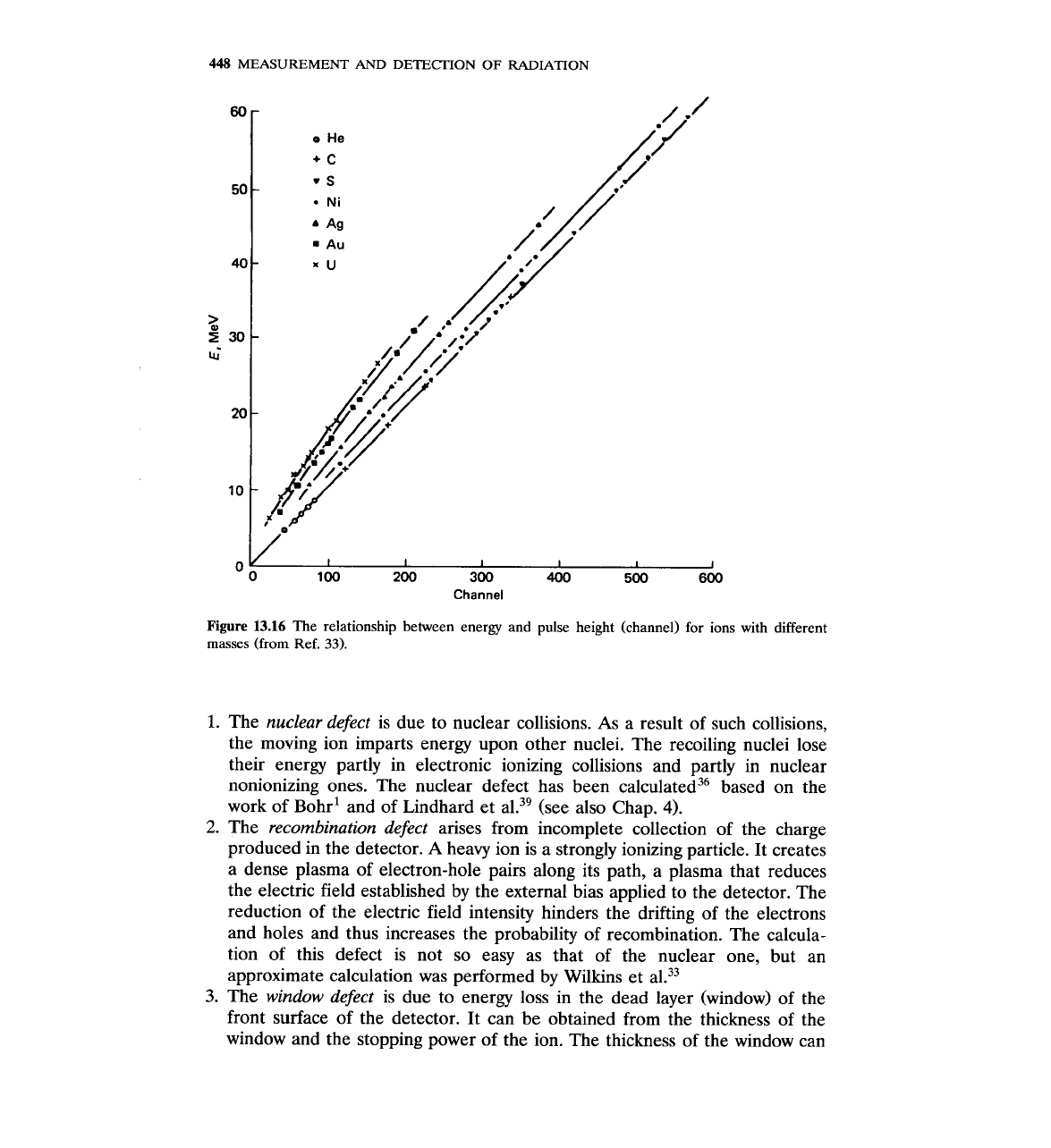
448
MEASUREMENT
AND
DETECTION
OF
RADIATION
Channel
Figure
13.16
The relationship between energy and pulse height (channel) for ions with different
masses
(from Ref.
33).
1.
The
nuclear defect
is due to nuclear collisions. As a result of such collisions,
the moving ion imparts energy upon other nuclei. The recoiling nuclei lose
their energy partly in electronic ionizing collisions and partly in nuclear
nonionizing ones. The nuclear defect has been
~alculated~~ based on the
work of
~ohr' and of Lindhard et a1.39 (see also Chap. 4).
2.
The
recombination defect
arises from incomplete collection of the charge
produced in the detector. A heavy ion is a strongly ionizing particle. It creates
a dense plasma of electron-hole pairs along its path, a plasma that reduces
the electric field established by the external bias applied to the detector. The
reduction of the electric field intensity hinders the drifting of the electrons
and holes and thus increases the probability of recombination. The calcula-
tion of this defect is not so easy as that of the nuclear one, but an
approximate calculation was performed by Wilkins et
a1.33
3.
The
window defect
is due to energy loss in the dead layer (window) of the
front surface of the detector. It can be obtained from the thickness of the
window and the stopping power of the ion. The thickness of the window can
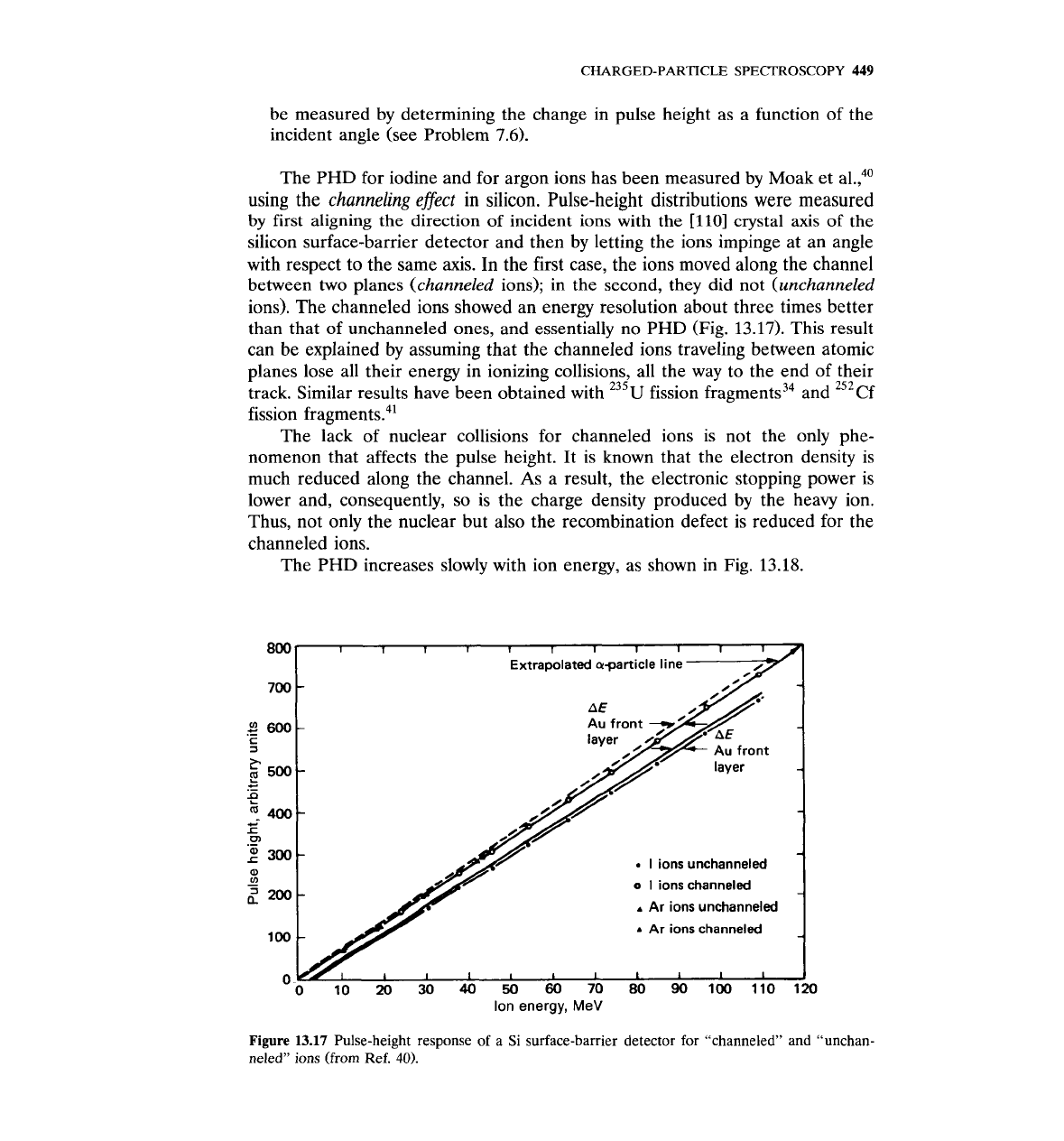
CHARGED-PARTICLE SPECTROSCOPY
449
be measured by determining the change in pulse height as a function of the
incident angle (see Problem 7.6).
The PHD for iodine and for argon ions has been measured by Moak et
a1.:'
using the
channeling effect
in silicon. Pulse-height distributions were measured
by first aligning the direction of incident ions with the
[I101
crystal axis of the
silicon surface-barrier detector and then by letting the ions impinge at an angle
with respect to the same axis. In the first case, the ions moved along the channel
between two planes (channeled ions); in the second, they did not (unchanneled
ions). The channeled ions showed an energy resolution about three times better
than that of unchanneled ones, and essentially no PHD (Fig. 13.17). This result
can be explained by assuming that the channeled ions traveling between atomic
planes lose all their energy in ionizing collisions, all the way to the end of their
track. Similar results have been obtained with
235~
fission and 252~f
fission fragmenk4'
The lack of nuclear collisions for channeled ions is not the only phe-
nomenon that affects the pulse height. It is known that the electron density is
much reduced along the channel. As a result, the electronic stopping power is
lower and, consequently, so is the charge density produced by the heavy ion.
Thus, not only the nuclear but also the recombination defect is reduced for the
channeled ions.
The PHD increases slowly with ion energy, as shown in Fig.
13.18.
800
I
I
I
I I
I
I
I I
Extrapolated olparticle line
.
l
ions unchanneled
o
I
ions channeled
.
Ar
ions unchanneled
A
Ar
ions
channeled
Ion energy, MeV
Figure
13.17
Pulse-height response of a Si surface-barrier detector for "channeled" and "unchan-
neled" ions (from Ref.
40).
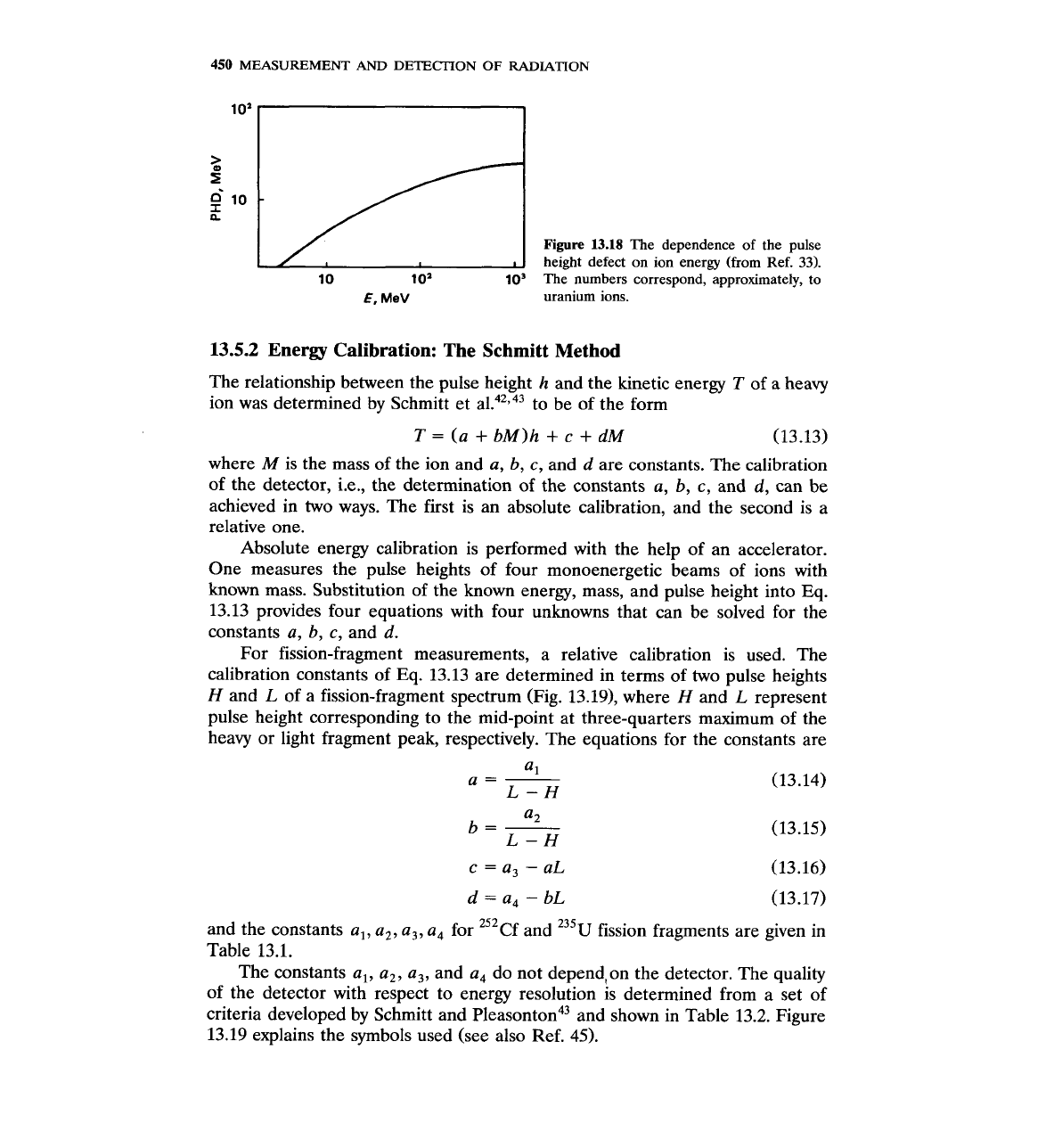
450
MEASUREMENT
AND
DETECTION
OF
RADIATION
p
10
!
I/
Figure
13.18
The dependence of the pulse
height defect on ion energy (from
Ref.
33).
10 10'
lo3
The numbers correspond, approximately, to
E,
MeV
uranium ions.
13.5.2
Energy Calibration: The Schmitt Method
The relationship between the pulse height
h
and the kinetic energy
T
of a heavy
ion was determined by Schmitt et a1.42,43 to be of the form
where
M
is the mass of the ion and
a,
b,
c,
and
d
are constants. The calibration
of the detector, i.e., the determination of the constants a,
b,
c,
and d, can be
achieved in two ways. The first is an absolute calibration, and the second is a
relative one.
Absolute energy calibration is performed with the help of an accelerator.
One measures the pulse heights of four monoenergetic beams of ions with
known mass. Substitution of the known energy, mass, and pulse height into Eq.
13.13
provides four equations with four unknowns that can be solved for the
constants a,
b,
c,
and
d.
For fission-fragment measurements, a relative calibration is used. The
calibration constants of
Eq.
13.13
are determined in terms of two pulse heights
H
and
L
of a fission-fragment spectrum (Fig.
13.19),
where
H
and
L
represent
pulse height corresponding to the mid-point at three-quarters maximum of the
heavy or light fragment peak, respectively. The equations for the constants are
a1
a=-
L-H
a2
b=-
L-H
c
=
a,
-
aL
and the constants a,, a2, a,, a, for 252~f and
235~
fission fragments are given in
Table
13.1.
The constants a,, a,, a,, and a, do not dependton the detector. The quality
of the detector with respect to energy resolution is determined from a set of
criteria developed by Schmitt and
leas on ton^^
and shown in Table
13.2.
Figure
13.19
explains the symbols used (see also Ref.
45).
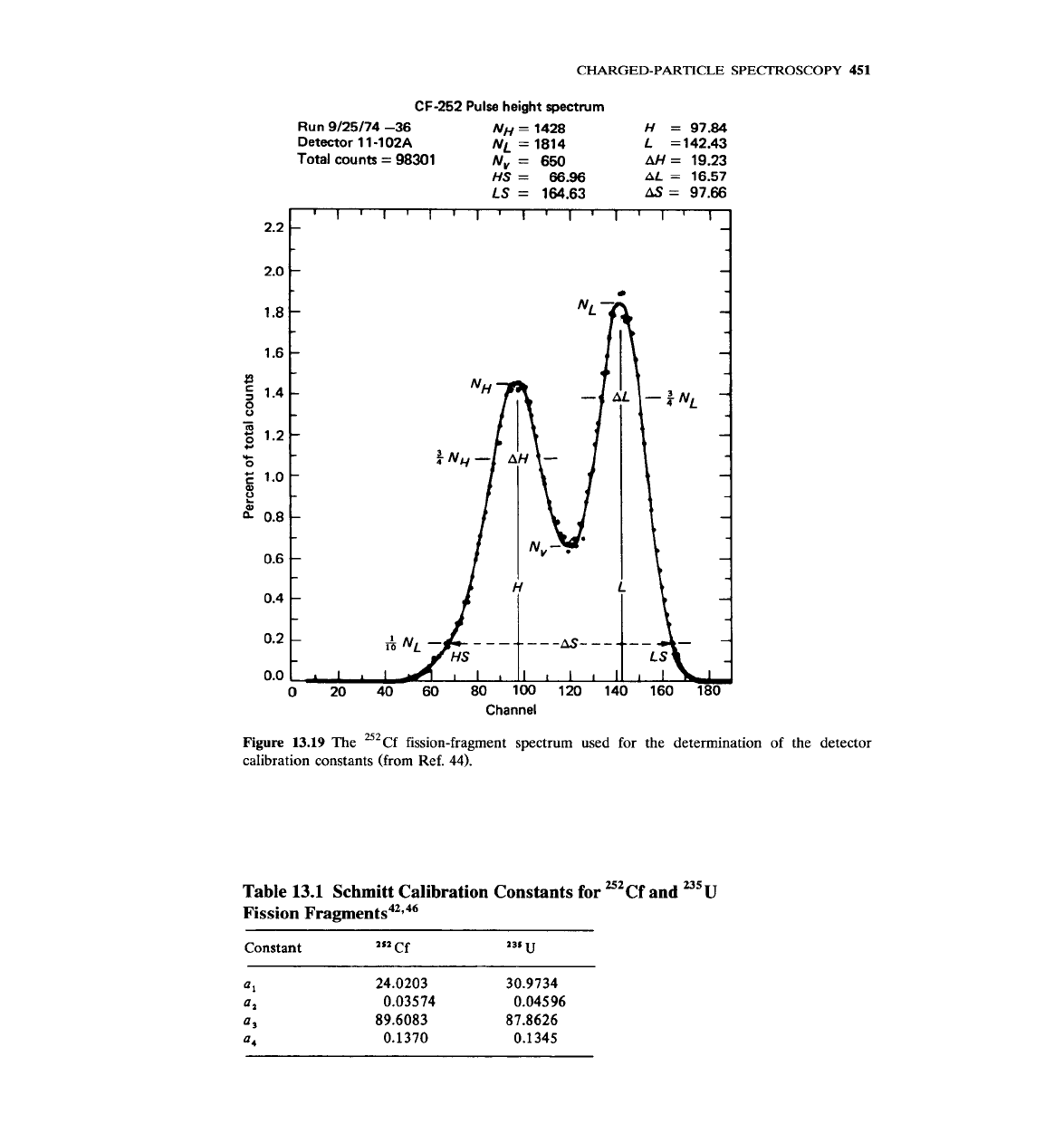
CHARGED-PARTICLE
SPECIROSCOPY
451
CF-252
Pulse height spectrum
Run
9/25/74
-36
NH
=
1428
H
=
97.84
Detector
1 1-1 02A
NL
=
1814
L
=
142.43
Total counts
=
98301
N,
=
650
AH
=
19.23
HS
=
66.96
AL
=
16.57
LS
=
164.63
AS
=
97.66
Channel
Figure
13.19
The 252~f fission-fragment spectrum used for the determination of the detector
calibration constants (from Ref.
44).
Table
13.1
Schmitt Calibration Constants for '''~f and
U5~
Fission
~ragrnents~~'~~
Constant
lr2
Cf
23s
"
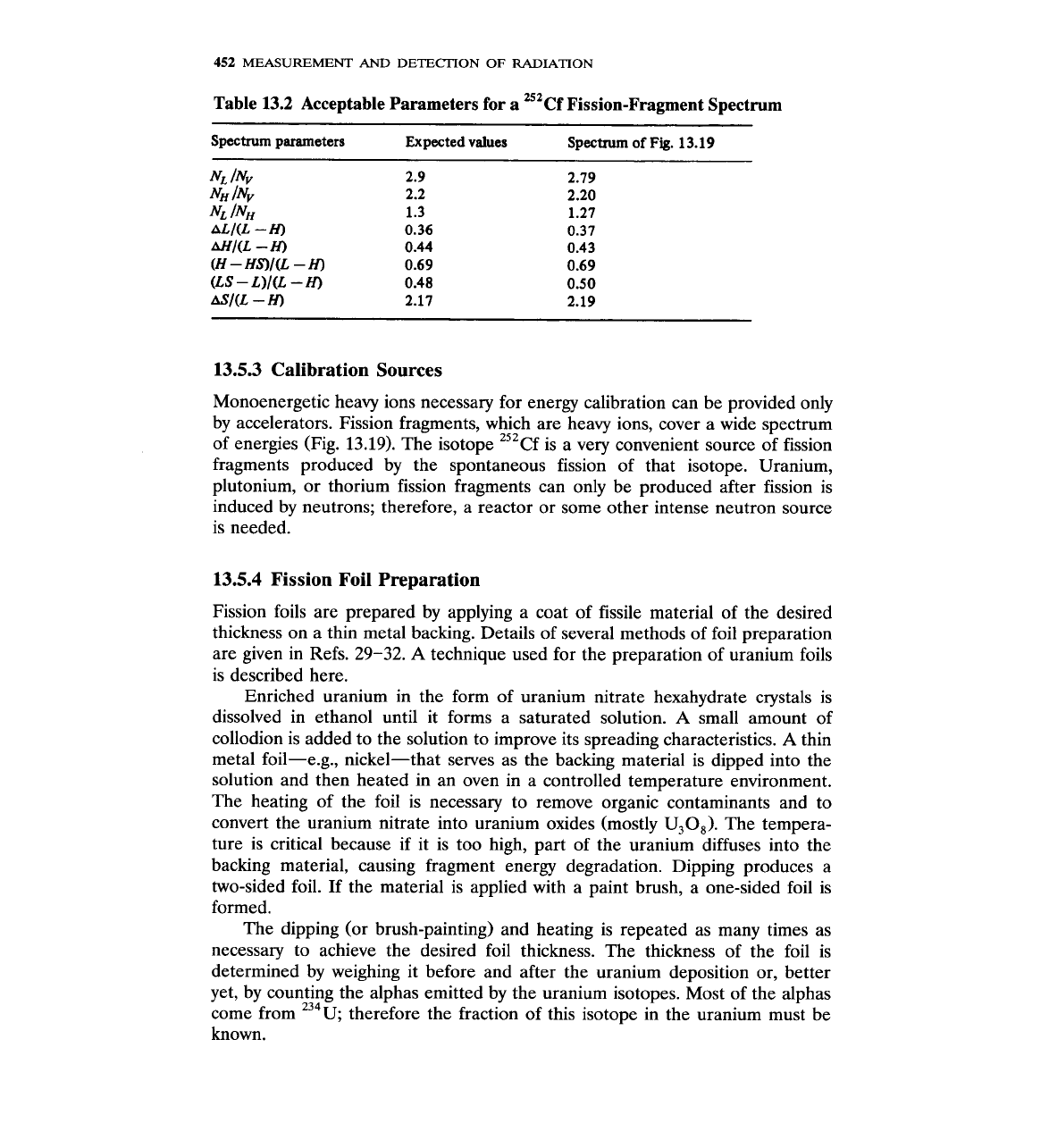
452
MEASUREMENT
AND
DETECTION
OF
RADIATION
Table
13.2
Acceptable Parameters for a 252~f Fission-Fragment Spectrum
Spectrum parameters Expected values Spectrum
of
Fig.
13.19
13.5.3 Calibration Sources
Monoenergetic heavy ions necessary for energy calibration can be provided only
by accelerators. Fission fragments, which are heavy ions, cover a wide spectrum
of energies (Fig. 13.19). The isotope 252~f is a very convenient source of fission
fragments produced by the spontaneous fission of that isotope. Uranium,
plutonium, or thorium fission fragments can only be produced after fission is
induced by neutrons; therefore, a reactor or some other intense neutron source
is needed.
13.5.4 Fission Foil Preparation
Fission foils are prepared by applying a coat of fissile material of the desired
thickness on a thin metal backing. Details of several methods of foil preparation
are given in Refs. 29-32.
A
technique used for the preparation of uranium foils
is described here.
Enriched uranium in the form of uranium nitrate hexahydrate crystals is
dissolved in ethanol until it forms a saturated solution.
A
small amount of
collodion is added to the solution to improve its spreading characteristics.
A
thin
metal foil-e.g., nickel-that serves as the backing material is dipped into the
solution and then heated in an oven in a controlled temperature environment.
The heating of the foil is necessary to remove organic contaminants and to
convert the uranium nitrate into uranium oxides (mostly
U,O,).
The tempera-
ture is critical because if it is too high, part of the uranium diffuses into the
backing material, causing fragment energy degradation. Dipping produces a
two-sided foil. If the material is applied with a paint brush, a one-sided foil is
formed.
The dipping (or brush-painting) and heating is repeated as many times as
necessary to achieve the desired foil thickness. The thickness of the foil is
determined by weighing it before and after the uranium deposition or, better
yet, by counting the alphas emitted by the uranium isotopes. Most of the alphas
come from
234~; therefore the fraction of this isotope in the uranium must be
known.
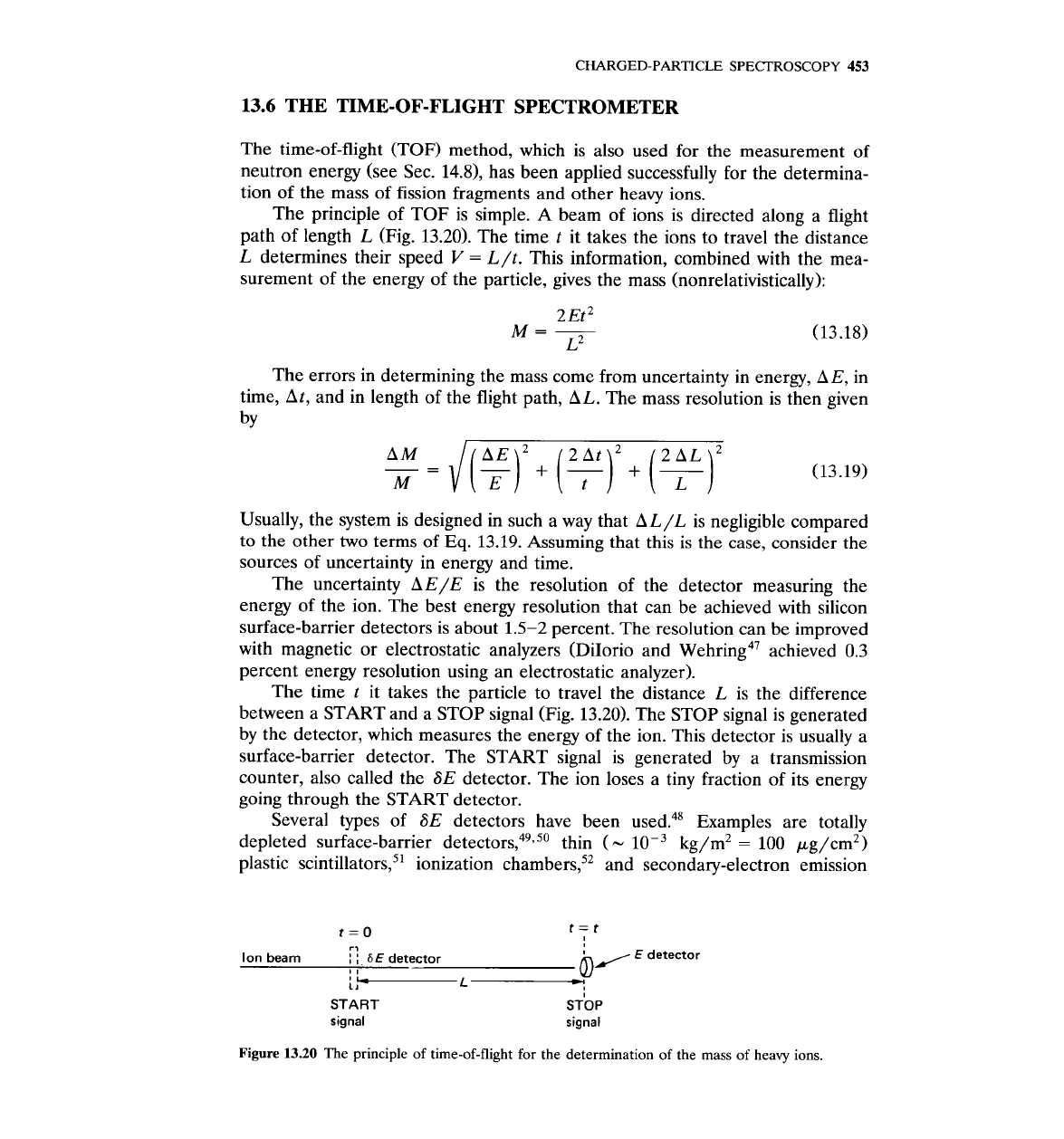
CHARGED-PARTICLE SPECTROSCOPY
453
13.6
THE TIME-OF-FLIGHT SPECTROMETER
The time-of-flight (TOF) method, which is also used for the measurement of
neutron energy (see Sec. 14.8), has been applied successfully for the determina-
tion of the mass of fission fragments and other heavy ions.
The principle of TOF is simple. A beam of ions is directed along a flight
path of length L (Fig. 13.20). The time t it takes the ions to travel the distance
L determines their speed
V
=
L/t. This information, combined with the mea-
surement of the energy of the particle, gives the mass (nonrelativistically):
The errors in determining the mass come from uncertainty in energy,
A
E, in
time, At, and in length of the flight path, AL. The mass resolution is then given
by
Usually, the system is designed in such a way that
A
L/L is negligible compared
to the other two terms of
Eq.
13.19.
Assuming that this is the case, consider the
sources of uncertainty in energy and time.
The uncertainty AE/E is the resolution of the detector measuring the
energy of the ion. The best energy resolution that can be achieved with silicon
surface-barrier detectors is about 1.5-2 percent. The resolution can be improved
with magnetic or electrostatic analyzers
(DiIorio and wehring4' achieved 0.3
percent energy resolution using an electrostatic analyzer).
The time
t
it takes the particle to travel the distance
L
is the difference
between a START and a STOP signal (Fig. 13.20). The STOP signal is generated
by the detector, which measures the energy of the ion. This detector is usually a
surface-barrier detector. The START signal is generated by a transmission
counter, also called the 6E detector. The ion loses a tiny fraction of its energy
going through the START detector.
Several types of
6E detectors have been used.48 Examples are totally
depleted surface-barrier
detector^,^^.'^
thin
(-
kg/m2
=
100 pg/cm2)
plastic
scintilla tor^,^^
ionization
chamber^,'^
and secondary-electron emission
ri
Ion
beam
I
I
6
E
detector
I
I
;,-L
START
signal
STOP
signal
Figure
13.20
The principle of time-of-flight for the determination of the mass of heavy ions.
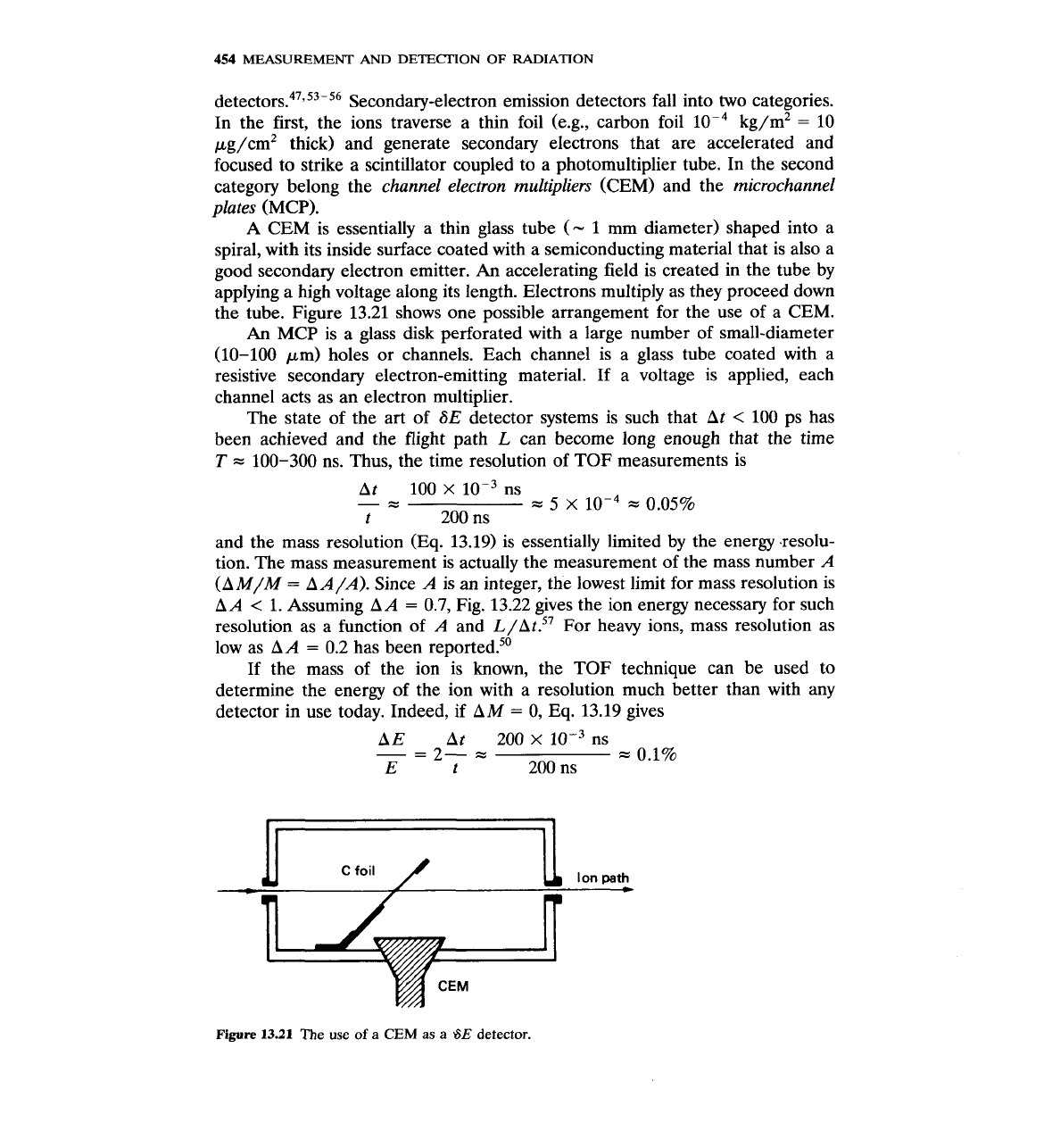
454
MEASUREMENT
AND
DETECTION
OF
RADIATION
dete~tors.~~,~~-~~ Secondary-electron emission detectors fall into two categories.
In the first, the ions traverse a thin foil (e.g., carbon foil
lop4
kg/m2
=
10
pg/cm2 thick) and generate secondary electrons that are accelerated and
focused to strike a scintillator coupled to a photomultiplier tube. In the second
category belong the
channel electron multipliers
(CEM) and the
microchannel
plates
(MCP).
A
CEM is essentially
a
thin glass tube
(-
1
mm diameter) shaped into a
spiral, with its inside surface coated with a semiconducting material that is also a
good secondary electron emitter.
An
accelerating field is created in the tube by
applying a high voltage along its length. Electrons multiply as they proceed down
the tube. Figure 13.21 shows one possible arrangement for the use of a CEM.
An
MCP is a glass disk perforated with a large number of small-diameter
(10-100 pm) holes or channels. Each channel is a glass tube coated with a
resistive secondary electron-emitting material. If a voltage is applied, each
channel acts as an electron multiplier.
The state of the art of
SE
detector systems is such that At
<
100 ps has
been achieved and the flight path
L
can become long enough that the time
T
-
100-300 ns. Thus, the time resolution of
TOF
measurements is
and the mass resolution (Eq. 13.19) is essentially limited by the energy .resolu-
tion. The mass measurement is actually the measurement of the mass number A
(A M/M
=
A
A/A). Since
A
is an integer, the lowest limit for mass resolution is
A
A
<
1.
Assuming
A
A
=
0.7, Fig. 13.22 gives the ion energy necessary for such
resolution as a function of A and
L/A~.~~
For heavy ions, mass resolution as
low as AA
=
0.2 has been rep~rted.~'
If the mass of the ion is known, the
TOF
technique can be used to
determine the energy of the ion with a resolution much better than with any
detector in use today. Indeed, if AM
=
0, Eq. 13.19 gives
Ion
path
-
Figure
13.21
The
use
of
a
CEM
as
a
6E
detector.
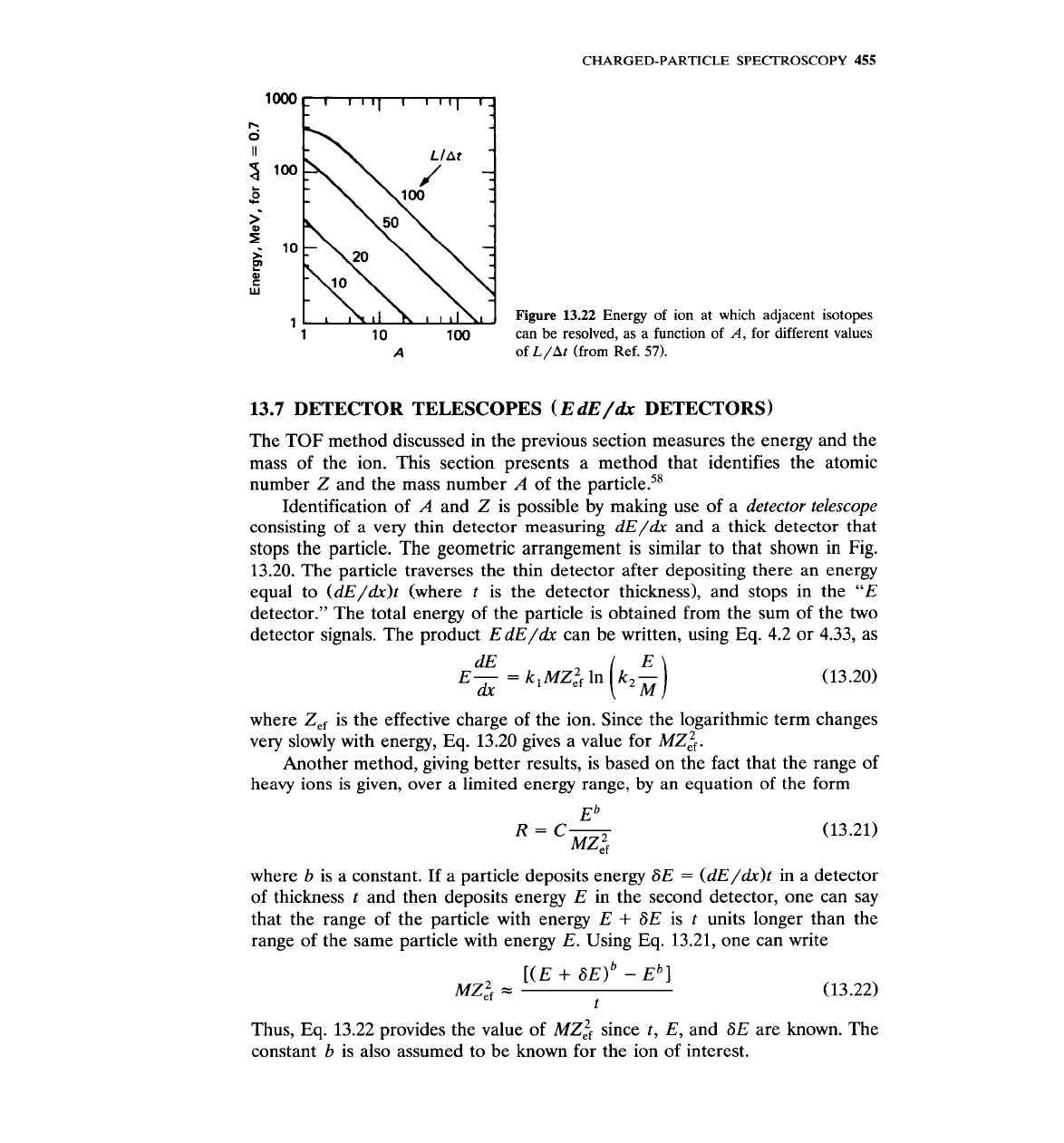
CHARGED-PARTICLE
SPECTROSCOPY
455
lmor-l'--T
Figure
13.22
Energy of ion at which adjacent isotopes
can be resolved, as a function of
A,
for different values
A
of
L/At
(from Ref.
57).
13.7
DETECTOR TELESCOPES
(E
dE/h
DETECTORS)
The
TOF
method discussed in the previous section measures the energy and the
mass of the ion. This section presents
a
method that identifies the atomic
number
Z
and the mass number
A
of the parti~le.~'
Identification of
A
and
Z
is possible by making use of a detector telescope
consisting of a very thin detector measuring
dE/&
and a thick detector that
stops the particle. The geometric arrangement is similar to that shown in Fig.
13.20. The particle traverses the thin detector after depositing there an energy
equal to (dE/dr)t (where
t
is the detector thickness), and stops in the
"E
detector." The total energy of the particle is obtained from the sum of the two
detector signals. The product E dE/h can be written, using
Eq.
4.2 or 4.33, as
where
Zef
is the effective charge of the ion. Since the logarithmic term changes
very slowly with energy,
Eq.
13.20 gives a value for
MZ~.
Another method, giving better results, is based on the fact that the range of
heavy ions is given, over a limited energy range,
by
an equation of the form
rb
where
b
is a constant. If a particle deposits energy
6E
=
(dE/&)t in a detector
of thickness
t
and then deposits energy E in the second detector, one can say
that the range of the particle with energy
E
+
SE is
t
units longer than the
range of the same particle with energy E. Using
Eq.
13.21, one can write
Thus,
Eq.
13.22 provides the value of
MZ;
since t, E, and SE are known. The
constant
b
is also assumed to be known for the ion of interest.
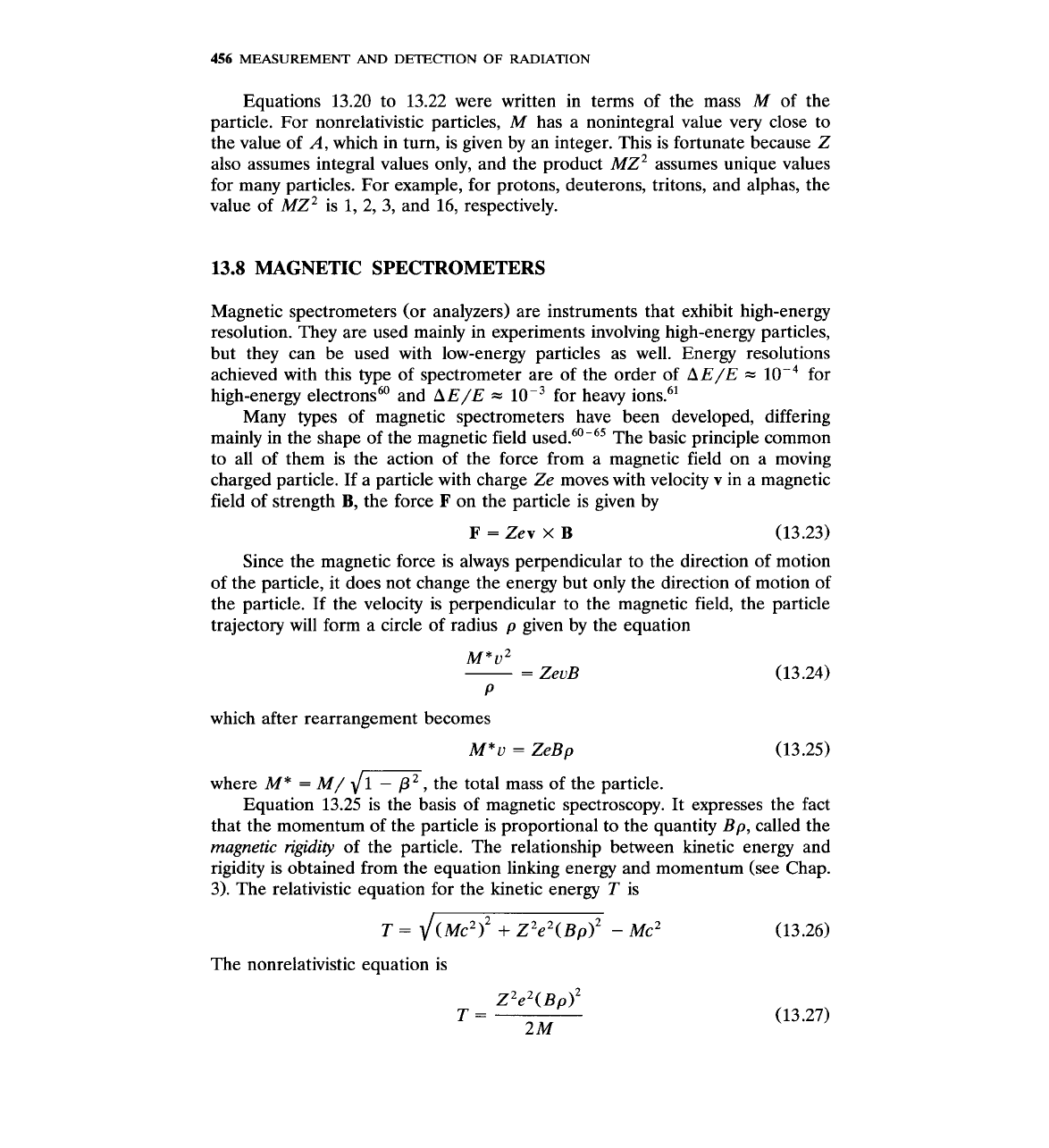
456
MEASUREMENT
AND
DETECTION
OF
RADIATION
Equations 13.20 to 13.22 were written in terms of the mass M of the
particle. For nonrelativistic particles, M has a nonintegral value very close to
the value of
A,
which in turn, is given by an integer. This is fortunate because Z
also assumes integral values only, and the product
MZ'
assumes unique values
for many particles. For example, for protons, deuterons, tritons, and alphas, the
value of MZ2 is 1, 2,
3,
and 16, respectively.
13.8
MAGNETIC SPECTROMETERS
Magnetic spectrometers (or analyzers) are instruments that exhibit high-energy
resolution. They are used mainly in experiments involving high-energy particles,
but they can be used with low-energy particles as well. Energy resolutions
achieved with this type of spectrometer are of the order of AE/E
=
lop4
for
high-energy electrons6' and AE/E
=
for heavy ions.61
Many types of magnetic spectrometers have been developed, differing
mainly in the shape of the magnetic field ~sed.~'-~' The basic principle common
to all of them is the action of the force from a magnetic field on a moving
charged particle. If a particle with charge Ze moves with velocity v in a magnetic
field of strength
B,
the force
F
on the particle is given by
F
=
Zev
X
B
(13.23)
Since the magnetic force is always perpendicular to the direction of motion
of the particle, it does not change the energy but only the direction of motion of
the particle. If the velocity is perpendicular to the magnetic field, the particle
trajectory will form a circle of radius p given by the equation
M*U~
=
ZevB
P
which after rearrangement becomes
M*v
=
ZeBp (13.25)
where M*
=
M/
41
-
p2, the total mass of the particle.
Equation 13.25 is the basis of magnetic spectroscopy. It expresses the fact
that the momentum of the particle is proportional to the quantity Bp, called the
magnetic
rigidity
of the particle. The relationship between kinetic energy and
rigidity is obtained from the equation linking energy and momentum (see Chap.
3). The relativistic equation for the kinetic energy
T
is
T
=
\I(MC')~
+
-
Mc2
The nonrelativistic equation is
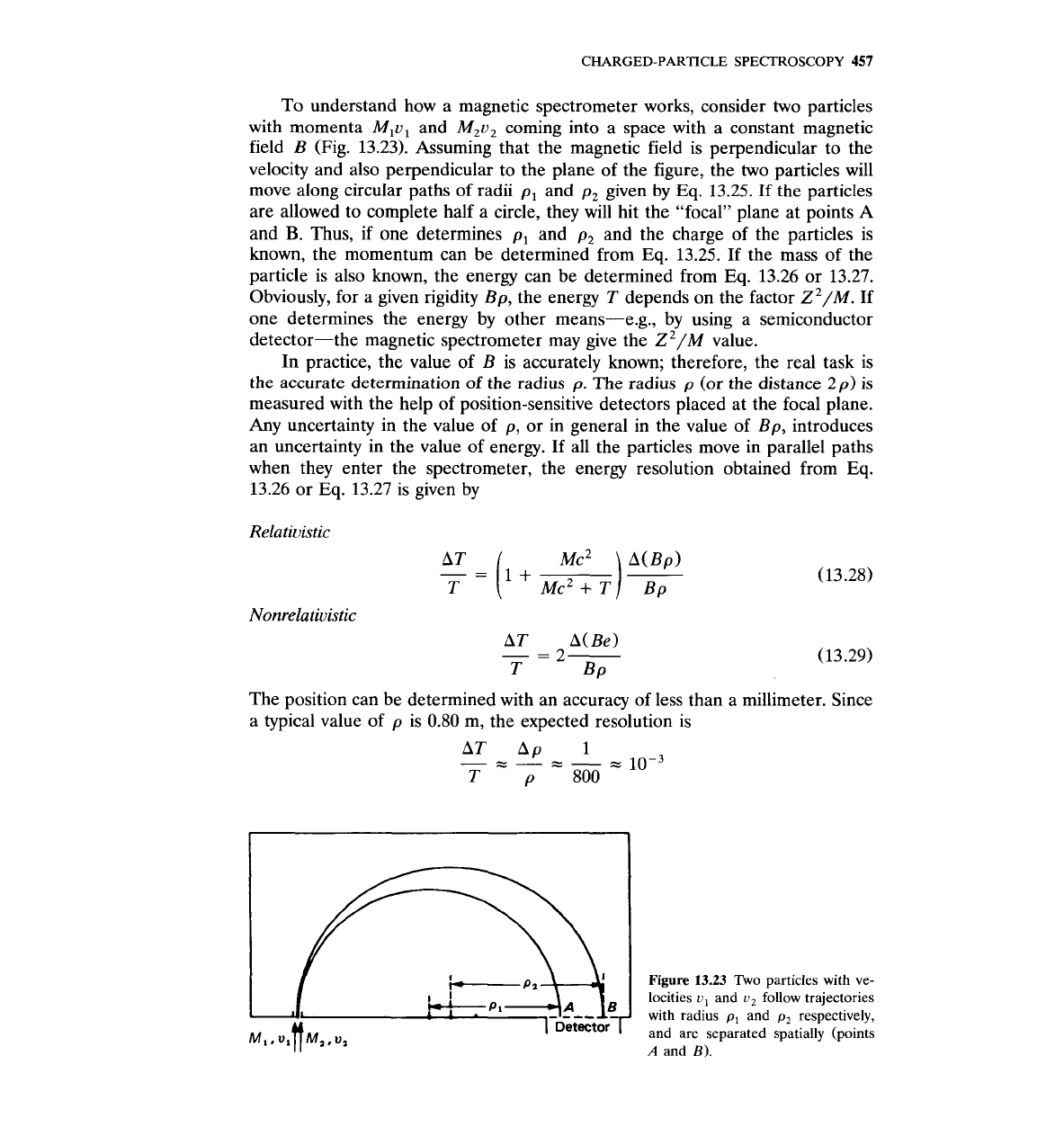
CHARGED-PARTICLE
SPECIROSCOPY
457
To understand how a magnetic spectrometer works, consider two particles
with momenta
Mlul
and
M2u2
coming into a space with
a
constant magnetic
field
B
(Fig. 13.23). Assuming that the magnetic field is perpendicular to the
velocity and also perpendicular to the plane of the figure, the two particles will
move along circular paths of radii p, and p, given by
Eq.
13.25.
If the particles
are allowed to complete half a circle, they will hit the "focal" plane at points
A
and
B.
Thus, if one determines
p,
and
p,
and the charge of the particles is
known, the momentum can be determined from
Eq.
13.25. If the mass of the
particle is also known, the energy can be determined from
Eq.
13.26 or 13.27.
Obviously, for a given rigidity Bp, the energy
T
depends on the factor
z2/M.
If
one determines the energy by other meansWe.g., by using a semiconductor
detector-the magnetic spectrometer may give the
Z2/M
value.
In practice, the value of B is accurately known; therefore, the real task is
the accurate determination of the radius
p.
The radius
p
(or the distance
2p)
is
measured with the help of position-sensitive detectors placed at the focal plane.
Any uncertainty in the value of p, or in general in the value of Bp, introduces
an uncertainty in the value of energy.
If
all the particles move in parallel paths
when they enter the spectrometer, the energy resolution obtained from
Eq.
13.26 or
Eq.
13.27 is given by
Relativistic
Nonrelativistic
AT A(
Be)
-
-
-
2-
T
BP
The position can be determined with an accuracy of less than a millimeter. Since
a typical value of
p
is
0.80
m, the expected resolution is
Figure
13.23
Two particles with ve-
locities
u,
and
u,
follow trajectories
with radius
p,
and
p,
respectively,
and are separated spatially (points
A
and
B).
